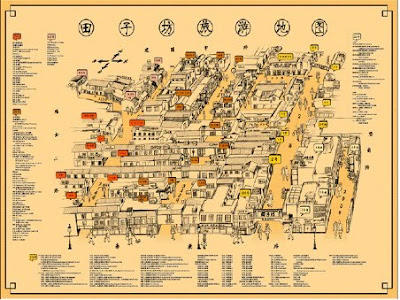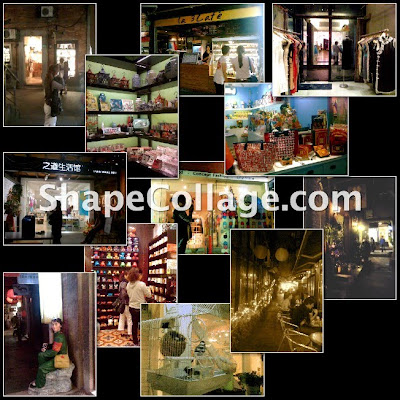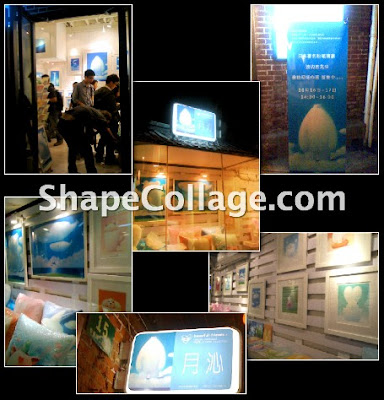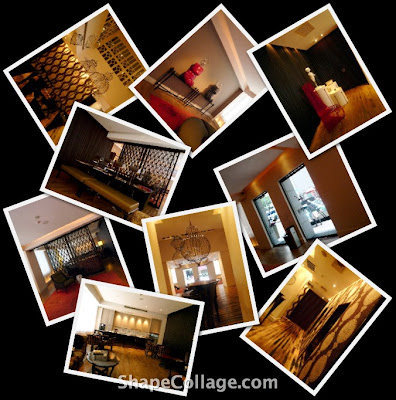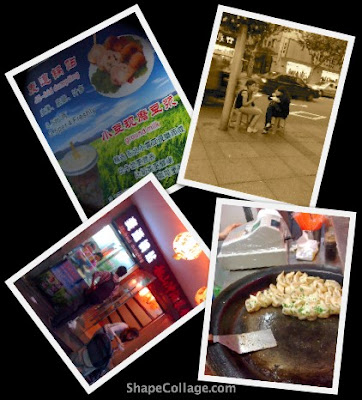Batam is a 45-50 minute ferry ride away from Singapore. There are a number of Batam ferry terminals with direct connections from Singapore’s Harbourfront ferry terminal, namely Batam Centre, Sekupang, Waterfront City and Harbour Bay. There are also ferries to Nongsapura, which depart from Tanah Merah Ferry Terminal, Singapore. A return ticket costs around 45-47 SGD (inclusive of taxes, terminal fees etc), depending on which ferry terminal you’re heading to and thus which ferry operator you’ll be travelling with. For ferry schedule and ferry operators’ contact list, see http://www.singaporecruise.com.
Lately, my favourite reason for visiting Batam is to get my hair done at Sibel hairdressing, located at Nagoya Hill. Nagoya Hill is this sprawling complex, located about 5-10 minutes cab ride away from Harbour Bay ferry terminal. The ride probably costs around 15 000 - 20 000 ruppiah. To be safe, board only the yellow-plate licensed Batam Taxis, and also negotiate your price beforehand. Nagoya Hill is anchored by Nagoya Hill Shopping Mall, which was supposedly the largest shopping mall in Batam when it opened in 2007 (not too sure if the “largest mall” label still applies today).
Nagoya Hill Shopping Mall - Pintu Barat entrance (as indicated on its pillar)
There is also a Polo brand corner, which retails the popular collared T-shirts featuring a prominent horseback-riding polo player logo and other Polo merchandise. The brand is popularly regarded as the Indonesian spin-off brand of the international Polo Ralph Lauren brand, and as such, seen by bargain hunters as an economical (though not as quality) version of Polo Ralph Lauren, as the prices can differ as much as by 1/3, if you compare a standard logo Polo Ralph Lauren collared tee with a standard logo Polo collared tee. But there’s quite a bit of internet discussion on the authenticity of Polo and after much trawling, I’m still confused as to if the Indonesian Polo is a) a genuine spin-off brand of Polo Ralph Lauren, which for some reason, is licensed in Indonesia as Polo, instead of Polo Ralph Lauren; b) a legal “imitation” of Polo Ralph Lauren (which due to licensing chronology issues, cannot sue the Indonesian Polo, as the name was registered in Indonesia prior to Polo Ralph Lauren), with merchandise made intentionally to resemble Polo Ralph Lauren’s or c) there exist both Polo by Ralph Lauren and the Indonesian Polo in Batam, the later being a local brand unrelated to Ralph Lauren and thus the “fake”, while the former is carried at only certain retail spots in Batam. Confused yet? So far, most of the Internet findings have not been conclusive, this authenticity issue seems pretty much left to investigative journalism, if it’s worth the time at all. My take on this, is that if you come across the Polo brand merchandise while you’re in Batam or other parts of Indonesia for that matter, and happen to like its merchandise, decide if you feel that the price is worth the quality, not just the supposed brand-name appeal and make your purchase based on that. That way, if you find out that Indonesian Polo is not related to Polo Ralph Lauren, you won’t feel that you’ve overpaid for an imitation product, as you’ve paid simply for what you feel that merchandise is worth, sans its brand-name. But as to if you’ve unintentionally assisted in the infringement of intellectual property? Oops.
The Matahari supermarket is good for browsing for groceries and Singaporeans are wont to cart back boxes of made-in-Indonesia Indomie mee goreng instant noodles, which supposedly taste better than the made-in-Malaysia ones found on Singapore supermarket shelves. On this recent trip, I did not manage to check if this is still the case, given the pretty recent scare about the possibility of banned preservatives in the Indomie, although the Indomie imported into Singapore were cleared with a food safety probe later on. See http://www.channelnewsasia.com/stories/singaporelocalnews/view/1086815/1/.html. Because they are hard to come by in Singapore, sometimes I buy back the Mie Sedap brand of mee goreng with jeruk nipis (lime flavour) instant noodles and Kusuka brand of flavoured tapioca chips (I especially enjoy the BBQ and sate pedas flavours). Keropok (deep fried crackers, of which Indonesia has an unusually large variety. Usually the sun-dried, pre-cooked versions are bought, to be fried back home) and Kueh Lapis (layered cake) are also popular snacks to cart back home. Matahari carries a range of keropok, but as for kueh lapis, the general preference is for freshly made cakes bought off bakeries or distributors for home-made versions (for example, such as the Isabella Massage House located in Nagoya Hill complex, which curiously offers sampling of kueh lapis and takes orders for its rather tasty home-made versions), rather than the pre-packed supermarket versions.
Nagoya Shopping Mall is also a place where Singaporeans can satisfy their nostalgic cravings for A&W fast food (especially the curly fries, root beer float and waffles) and Baskin Robbins ice cream, as these 2 brands are now defunct in Singapore. Don’t be surprised if you see Singaporeans making a beeline for A&W as soon as they set foot in Batam (or anywhere else in the region for that matter). It doesn’t matter if sometimes the queue is long and the wait turns out longer than expected for fast food service, or if on a bad day, the root beer float turns out flat and tepid and the curly fries limp. Singaporeans have an almost herd-like instinct to satisfy their long-drawn A&W cravings, if only because it was, after all, many Singaporean's foremost taste of American fast food, seeing that it was the first fast food chain to set up operations in Singapore, back in 1966. See: http://heritagetrails.sg/content/237/First_A_W_Restaurant.html.
While Batam is popular for its cheap seafood, I’ve unfortunately yet to come across one that I’ve liked enough to recommend. I’ve been to one or two kelong (fish farm/restaurants on stilts)-style seafood restaurants that are popular with tour groups, which while cheap, don’t exactly cut it quality and taste-wise. The only seafood restaurant I’ve tried recently at Nagoya Hill Shopping Mall failed to satisfy as well. Maybe I’m too fussy. My Batam hair stylist did recommend one on this recent trip, unfortunately, I did not have sufficient time to check it out. I’ll remember to post it if I ever do get to try it out later and if it turns out well. But if you do have seafood in Batam, you may wish to order “gong gong” - sea snails, which are supposedly a local specialty found only in the waters off Batam and Bintan. The snails are usually served simply steamed in their shells, with no dressing. You pull out the flesh by its tail or with the aid of a toothpick and dip them in the accompanying sambal chilli sauce and devour the mollusc whole, save for its prickly tail.
So instead of feasting on seafood, I satisfy my craving for Ayam Penyet. The famous one, with chains all over Indonesia and beyond, and I just found out, outlets in Singapore (Lucky Plaza) is Ayam Penyet Ria (Khas Ibu Ruth). It’s located at the Food Street of Nagoya Hill Shopping Mall (on its second level, most easily accessed by the Pintu Barat – west door entrance, where the A&W is located. The other entrance of the mall is on the opposite end, Pintu Timur – east door).
Food Street
Ayam Penyet Ria (Khas Ibu Ruth)
Address: Ruko Nagoya Hill G2, Batam, Indonesia
Tel: (0778) 7493 529 (if calling from outside of Indonesia, the country code for Indonesia is 62, so its +62 778 7493 529). On subsequent visits, you may wish to ask them for their BBM (black berry messenger) number for appointments.
Hours: 1000 – 2000 (closed on Tuesdays)
Price: 160 000 ruppiah for hair spa therapy (other hair therapies are available from 60 000 – 90 000 ruppiah); 140 000 – 166 000 for hair cut by Dorris. Pay in ruppiah only. I forgot to check if they accept credit cards.
Tip: Ask to change into a tube-wrap before your hair spa therapy, if you do not wish to stretch your shirt collar, the shampoo boy tends to tug your shirt collar when they need to massage your bare shoulders.
We had our massage at Eska. Again, Eska is most accessible from the Pintu Barat entrance of Nagoya mall, in fact, you’ll find it just right across the road from the A&W.
Eska Wellness Spa Massage and Salon
In addition to spa and massage services, Eska also has a whole range of beauty and hair services spread out over its 3-4 levels – manicure, pedicure, facial and a hair salon on its first level. I tried the package 1 (240 000ruppiah before tax), which is a 2-hour session, which consists of a facial, massage and foot reflexology treatments. The treatments are mostly carried out in curtained partitions. I think the men and women massages are conducted on separate floors. If you book the spa package, which consists of a bath treatment, for example the 3-hours birthday retreat package, you should get a room that comes with its own tub. Otherwise for non-bath packages or ala carte treatments where you have the body scrub, they are mostly conducted in the curtained partitions and you will have to make your way to the common bathroom at the end of each floor, to shower off. Because I had three different types of treatment, I had to shuttle between floors for each different treatment, but it should not be much of an inconvenience to most abled bodies. While the receptionists at Eska are conversant in English and Chinese, in addition to Bahasa; most of the therapists are fluent in Bahasa only and speak at most, a smattering of English. But no matter, arm yourself with a few useful Bahasa phrases and you should be able to enjoy your sessions. For example, the therapist may ask you “sini boleh?” – which roughly translates to “is this ok?” And if you find the massage pressure good, you reply “boleh” (ok), but if you prefer it to be softer or gentler, you can say “pelan” (pronounced “per – lahn”), or if you prefer it harder or stronger, you can say “kuat”. It’s a little trickier with the facial, I find myself struggling to communicate that I prefer not to do extraction, unless they have a pore-closer/toner to apply afterwards. Yes, it’s a tad too specific to be effectively translated with my broken Bahasa. Though the therapist did try her best with her broken English to reach a compromise too. And as always, it’s good manners to thank your therapists with a “Terima Kasih” (pronounced “Te-ri-ma Kah-see”in Bahasa Indonesia, not to be confused with “Te-ri-ma Kah-seh” in Bahasa Melayu – spoken in Malaysia, Singapore and Brunei), and a nice optional tip.
Eska Wellness Spa Massage and Salon
Address: Ruko Nagoya Hill Blok R4, F3 & F3A, Batam, Indonesia
Tel: +62 778 7493866
Website: www.eska-wellness.com (convenient for checking menu prices and reservations through online booking form at http://www.eska-wellness.com/registration.php). Eska accepts ruppiah, Singapore dollars (at prevailing exchange rate) and credit cards.
Hours: 1000 – 2200
Tip: Eska provides complimentary 1-way transport, either pick-up or return to ferry terminal or hotel.
So, all in all, Batam can be a convenient and affordable quick getaway, where you get to indulge in affordable pampering and cheap grub. Just remember to factor in the 1-hour time difference (Batam is one hour behind, GMT + 7) if you plan your itinerary around the ferry schedules.

